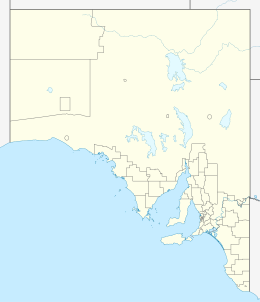Hopkins Island
| Geography | |
|---|---|
| Location | Spencer Gulf |
| Administration | |
|
Australia
|
|
Hopkins Island is an island located in Spencer Gulf off the east coast of Jussieu Peninsula on Eyre Peninsula in South Australia approximately 32 km (20 mi) south-east of Port Lincoln. It was named by Matthew Flinders in memory of John Hopkins who was one of the eight crew lost from a cutter that capsized on 21 February 1802. Since 2004, the island has been part of the Memory Cove Wilderness Protection Area.
Hopkins Island is located approximately 32 km (20 mi) south-east of Port Lincoln and 1.3 km (0.81 mi) west of Carrington Point, on the west coast of Thistle Island. The island is triangular in plan with its long axis being approximately 1,900 m (6,200 ft) and it maximum width being about 950 m (3,120 ft). Its long axis is aligned in a north-east direction, similar to that of the north-west coast of Thistle Island. The island has an area of 162 ha (400 acres)and has a maximum height of 69 m (226 ft) near its south west end. Access by boat is possible at the small beach on the island’s north coast.
Hopkins Island was formed about 7000 years ago after sea levels rose at the start of the Holocene. The island has a perimeter consisting of granite over which ‘a flat upper plateau’ of calcarenite sits and which supports ‘a thick soil bed’. The island rises from the seabed at 30 m (98 ft) from within 200 m (660 ft) of its north west coast while the same transition occurs over a distance of almost 600 m (2,000 ft) on its south coast. On its north east coast, the passage between the island and Thistle Island is relatively shallow with a maximum charted depth of 11 m (36 ft) due to both islands sharing the same geological base strata.
As of 1996, a shrubland dominated by marsh saltbush grows in the deeper soil present on most of the upper platform. tussock grass and nitre bush is present in locations where thinner soils lying over underlying ridges of rock. heath bluebush dominates the thinner exposed soils on the island’s perimeter. Weed species were represented by African box thorn, common iceplant, and grasses such as red brome and rat's-tail fescue. It was suggested that these weed species have been successful due to various attempts to develop a pasture on the island suitable for grazing.
...
Wikipedia

